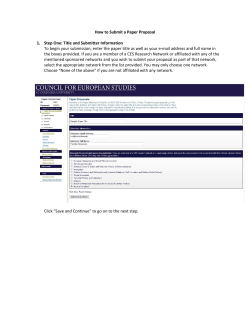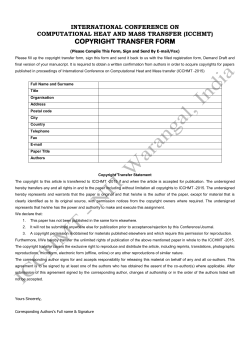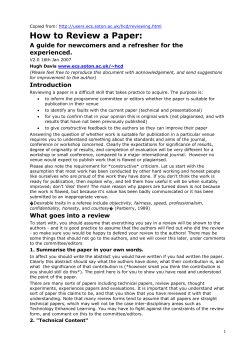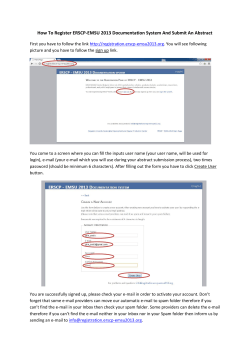
Publishing with IMPACT
Publishing with Impact How to get your article published and ensure it makes an impact in an increasingly digital environment Peter Sidebotham, Editor, Child Abuse Review, University of Warwick Jane V. Appleton, Editor, Child Abuse Review, Oxford Brookes University Andrea Pass, Journals Publishing Manager Why publish in a journal? • To gain prestige – association with key title/ leading editors/ authors in the field • To improve your work via the rigorous peer review process • To have a voice - engaging with key debates • To explore new ideas and methods • To challenge existing ideas • To enhance the visibility and reach of your work How does journals publishing work? PART ONE: BEFORE YOU PART TWO: SUBMISSION TO SUBMIT THE EDITORIAL OFFICE 1. Find a suitable journal for your research – look at Aims and Scope 2. Write your article – take care to adhere to the Author Guidelines 3. Submit your article online via the Electronic Editorial Office system 4. Editorial Office send article for double blind peer review 5. You receive the Peer Reviewers comments. Make any necessary corrections. PART THREE: PRODUCTION 8. Author checks proof. Makes any necessary corrections. 7. Production team send article for copyediting and typesetting. 6. Article finally accepted by Editors. Sent from Editorial Office to Production team 9. Author signs Copyright agreement 10. Final accepted article is sent for publication on Early View. It can now be cited. 11. Table of Contents alert notifies readers of article’s publication 12. Article is allocated an issue – it is published in an online issue and then in print How can I find help? You can find a useful overview of the whole publication process in our Journal Author guide in the Author Resources section of the Wiley Exchanges blog: http://exchanges.wiley.com/authors/ This gives tips for writing, info about copyright and permissions, publication ethics and the different stages of production, as well as guidance on post-publication activities BE AWARE: Journals Publishing is changing! • Journal readership is increasingly moving online and print runs are shrinking • Over 99% of institutions have onlineonly access to CAR • In an increasingly digital environment, there are new challenges for authors. It’s important to think about: Maximising discoverability Engaging with online communities Adding value to content and improving accessibility Publishing in CAR: Key information • Edited by Jane V. Appleton and Peter Sidebotham • A peer-reviewed, interdisciplinary forum for professionals in the field of child protection, giving access to latest research findings, practice developments, training initiatives and policy issues • 2013 Impact Factor: 0.787. 21/40 in Social Work. 27/39 in Family Studies • Official journal of BASPCAN • Available in c.8600 institutions worldwide • 175,556 article downloads globally in 2014 Why do you read a journal article? • Keeping up to date • Stimulating reflective practice • Seeking evidence to inform practice and policy • Informing further research Evidence-Informed Practice • The conscientious, explicit and judicious use of current best evidence, integrated with clinical expertise and an understanding of the context of the case, to guide decision making about the care of individual children What are the editors looking for? • Does this paper add to the evidence? • Does this paper help inform practice and policy? • Will this paper stimulate reflective practice? • Will this paper inform further research? • Is this a paper that others will read, download, cite? Some key questions • • • • • • • Is there a clear, concise message? Is it original? Is the paper well-written and readable? Is the methodology robust and appropriate? Are the results meaningful? Are the conclusions justified? Has the author considered the readers? Before submitting your paper • Follow the author guidelines – you can find these on the journal homepage: www.wileyonlinelibrary.com/journal/car • Keep it brief and to the point – 3,000 – 5,000 words (1,000 – 2,500 SR) – 35 references – Is there material that could be in an appendix? • Follow the statistical guidelines • Ask someone else to read it • Look out for forthcoming Special Issues Format • • • • • • • • Abstract: 200 words (not for SR) Key Practitioner Messages Key words Main Text References (follow the guidelines) Tables and illustrations Appendices No footnotes The Main Text • Background: keep it brief, justify your paper; aims of your paper • Methods: clear, reproducible, relevant; ethics • Results/Findings: clear, succinct; use tables and diagrams • Discussion: interpretation of results; relation to previous research; implications for practice/policy; strengths and limitations • Conclusions: Brief and justified Types of papers • • • • • • • Case studies/case series Cohort and case-control studies Intervention studies Structured and systematic reviews Research into practice Practice evaluation Qualitative studies How do I ensure that my article makes an IMPACT? The Wiley Journal Author Promotional Toolkit is available on our Exchanges blog: http://exchanges.wiley.com/authors /promo This gives useful tips about how best to ensure that your work is discovered, read and cited Let’s explore some important areas to think about: Search Engine Optimisation Many readers use search engines, such as Google Scholar, to search for papers of interest to them. SEO = optimizing your paper so it comes at the top of the results provided by a search engine. Top of the search results leads to: • Greater click throughs • More downloads • Increased citations potential Tips to make your article discoverable • Carefully select relevant keywords Researchers will often look for key phrases not just single words so try to include a couple of 2-4 word phrases in your keywords • Lead with keywords in the article title • Repeat keywords 3-4 times throughout the abstract, in a natural manner • Include at least 5 keywords and synonyms in the keyword field • Use headings (incorporating your keywords) • Stay consistent - refer to authors’ names and initials in a consistent manner throughout the paper • Cite your own, or your co-authors, previous publications – if appropriate • Link to the published article on social media, blogs and academic websites Social Media: promote your article to your network and beyond • Share the link to your article on twitter, facebook, linkedin and other social networks • Connect with the Wiley Community twitter feed @WBPsychology • Use Altmetric to explore where your work is being discussed and forge new networks • Could you encourage engagement with your article by recording an accompanying podcast or video abstract? Thank you for listening! Any questions?
© Copyright 2025











